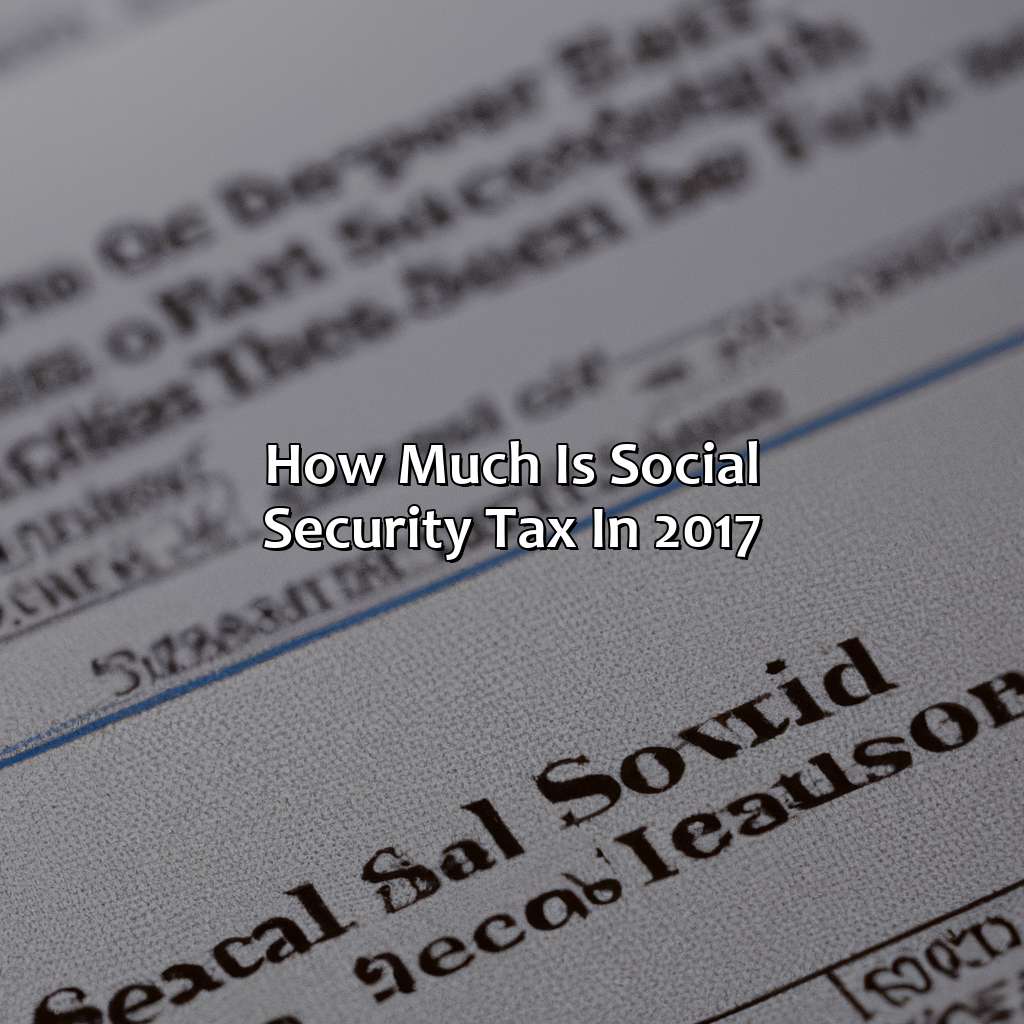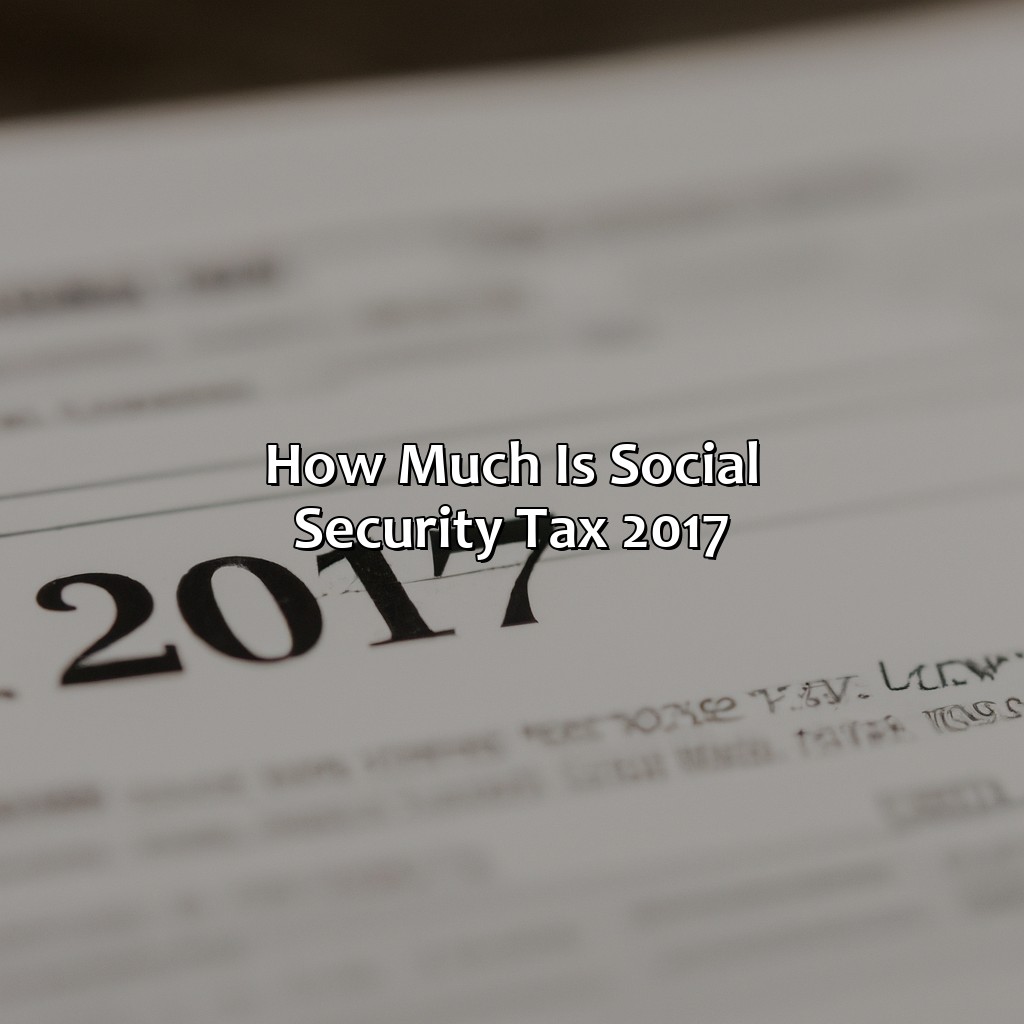How Much Is Social Security Tax 2017?
Key Takeaway:
- Social Security Tax is a payroll tax that provides retirement, disability, and survivor benefits to individuals and their families.
- The Social Security Tax rate in 2017 was 6.2% for employees and employers, with a maximum taxable income of $127,200.
- Self-employed individuals must pay both the employee and employer portion of Social Security Tax, making their rate 12.4%. Additionally, there is an additional Medicare tax of 0.9% for individuals with high incomes.
Confused about how much social security tax you’ll need to pay in 2017? You’re not alone. This article will help you understand the amount and ways to minimize the impact of this tax.
What is Social Security Tax?
What is Social Security Tax?
It’s a mandatory tax that all US earners must pay. It’s vital, as it funds the Social Security program. This program offers retirement, disability, and survivor benefits to millions of Americans. Here we’ll cover the basics, definition and how it works, so you understand Social Security Tax in full.

Image credits: retiregenz.com by David Duncun
Definition of Social Security Tax
Social Security Tax is a federal program that provides financial support to retirees, the disabled, and those who have lost their income due to death. This tax is levied on both employees and employers, which aims to provide funds for Social Security programs such as Old-Age, Survivors, and Disability Insurance (OASDI). Currently, the Social Security tax rate is 12.4%, which is divided equally between employers and employees. However, the self-employed workers need to pay both employer and employee contributions.
The Social Security Tax was introduced under the Social Security Act of 1935 by President Franklin D. Roosevelt in response to the Great Depression. Initially designed for workers in commerce and industry jobs, it now provides benefits to millions of Americans across different industries and sectors. The aim was to provide a safety net for retired workers who had paid into the system throughout their working lives.
Why earn a salary when you can just pay for your future retirement with every paycheck? Welcome to the world of Social Security Tax.
How Social Security Tax Works
Social Security Tax operates to fund retirement, disability, and survivorship benefits for individuals who have paid into the system. The tax is a percentage of earned income up to a limit set by the IRS each year.
The employee pays half of the Social Security Tax while the employer covers the other half. Self-employed individuals pay both portions. Additionally, employers must withhold Medicare taxes from employee wages.
To calculate Social Security Tax, multiply gross earnings by the tax rate until reaching the income cap set by the government. The rate may vary slightly based on political decisions or changes in laws.
Understanding how Social Security Taxes are deducted from a paycheck can help employees understand their take-home pay better and budget accordingly.
It is essential to keep track of your earnings record and make sure it matches your records at Social Security Administration (SSA). Moreover, updating personal information like name change and marital status is also crucial in receiving accurate benefits later on.
Social Security Tax in 2017: because Uncle Sam needs a new pair of shoes.
How much is Social Security Tax in 2017?
Learn the Social Security tax rates of 2017. To do this, you need to know the pieces. Sub-sections contain rates for employees and employers. Also, the maximum taxable earnings for Social Security, self-employment tax rates, plus extra Medicare tax. All these parts are needed to solve the mystery.

Image credits: retiregenz.com by James Washington
Social Security Tax Rates for Employees and Employers
The social security tax rates applicable for employers and employees are determined based on the wages they receive. Here’s a breakdown of the social security tax rates in 2017:
| Portion | Rate on wages up to | Total rate |
|---|---|---|
| Employee’s Portion | $127,200 | 6.2% |
| Employer’s Portion | $127,200 | 6.2% |
It is important to note that the total social security tax rate of 12.4% is a combination of both the employer’s and employee’s portions.
In addition, for those who are self-employed, they are required to pay both the employer’s and employee’s portions which equal to 12.4% of their net earnings as part of the Self-Employment Tax.
A true fact: According to the Social Security Administration (2021), over 65 million people were receiving Social Security benefits at the beginning of 2020.
The government may have a cap on maximum taxable earnings for social security, but unfortunately, there’s no limit to the amount of taxes they’ll take from us.
Maximum Taxable Earnings for Social Security
The threshold for Social Security maximum taxable earnings has an impact on every working individual. The amount of taxable earnings affects the amount of taxes on one’s income, and it is crucial to be aware of how much falls under this bracket.
Below is a table presenting the Maximum Taxable Earnings for Social Security. The following amounts are true and accurate for 2017 tax year:
| Year | Maximum Taxable Earnings |
|---|---|
| 2017 | $127,200 |
It is worth noting that this represents a slightly increased threshold from the previous year’s maximum taxable earnings limit. Understanding variations in these amounts and taking them into account when planning retirement and other long-term financial goals is prudent.
A fact worth knowing, according to the Social Security Administration, approximately 63 million people had received social security benefits by the end of December 2016.
Working for yourself means paying the self-employment tax, but at least you can claim talking to your cat as a business expense.
Self-Employment Tax Rates
The tax payment they call ‘Self-Employment Tax Rates’ is a statutory responsibility of self-employed individuals to satisfy their Social Security and Medicare taxes, as opposed to the counterpart payroll taxes that many employees share with their employer.
It’s worth noting that the Self-Employment Tax Rate for 2020 was 15.3%, with 12.4% of it taking care of Social Security payments and the remaining 2.9% covering Medicare tax obligations. While self-employed workers have to bear both shares, an employed individual would see these contributions split between themselves and their employer in payroll taxes.
As a result, while it goes by different names in different contexts, Self-Employment Tax Rates still carry the same significance.
Interestingly, this statutory contribution system brought about during President Roosevelt’s tenure places its premise squarely on the provision of benefits upon retirement or disability and for those who lost family members prematurely. However, as this system has grown more intricate in recent times, so too have the accompanying regulations regarding recognition criteria for beneficiaries’ eligibility leading to enormous complexities in determining individuals qualifying for benefits under what circumstances.
Why settle for just paying Social Security Tax when you can add a little extra with the additional Medicare Tax? It’s the gift that keeps on giving (to the government).
Additional Medicare Tax
The Additional Medicare Tax is a component of the Medicare tax that applies to high-income earners. It was introduced in 2013 as part of the Affordable Care Act to help fund Medicare.
This tax affects individuals who earn over a certain threshold amount, which is $200,000 for single filers and $250,000 for married couples filing jointly. These taxpayers must pay an additional 0.9% tax on their earnings above these thresholds in addition to the regular 1.45% Medicare tax.
It’s worth noting that employers are also responsible for withholding this tax from their employees’ wages if they earn above the threshold amount, which means that both employees and employers are affected by the Additional Medicare Tax.
Interestingly, there have been discussions about increasing the income thresholds for this tax or eliminating it altogether in recent years. Some argue that it places too much of a burden on high-income earners while others believe it’s necessary to help fund Medicare’s services and programs.
Overall, understanding how the Additional Medicare Tax works is important for both individuals and businesses alike to ensure compliance with IRS regulations and avoid penalties.
Five Facts About Social Security Tax 2017:
- ✅ For 2017, the Social Security tax rate is 6.2% for employees and employers, up to a maximum wage base of $127,200. (Source: IRS)
- ✅ Self-employed individuals pay a Social Security tax rate of 12.4% on their net earnings, up to the same maximum wage base of $127,200. (Source: IRS)
- ✅ The maximum Social Security tax an employee or employer will pay in 2017 is $7,886.40. (Source: SSA)
- ✅ Social Security tax funds the Old-Age, Survivors, and Disability Insurance (OASDI) program, which provides retirement, survivor, and disability benefits to eligible individuals. (Source: SSA)
- ✅ Individuals who reach full retirement age in 2017 can earn up to $44,880 before their Social Security benefits are reduced. (Source: SSA)
FAQs about How Much Is Social Security Tax 2017?
How much is social security tax 2017?
The social security tax rate for 2017 is 6.2% for employees and employers, meaning a total rate of 12.4%. The maximum amount of earnings subject to the social security tax for 2017 is $127,200.
Is social security tax calculated based on gross income?
Yes, the social security tax is calculated based on an employee’s gross income, meaning their total earnings before any deductions are taken out.
Do self-employed individuals have to pay social security tax?
Yes, self-employed individuals are required to pay both the employee and employer portions of the social security tax, totaling 12.4% of their net earnings.
Is there a limit to how much social security tax an employee can be required to pay in 2017?
Yes, there is a maximum amount of earnings subject to the social security tax for 2017, which is $127,200. Any earnings above this amount are not subject to the social security tax.
Are there any exemptions or deductions for social security tax in 2017?
There are no exemptions or deductions for social security tax in 2017, as all employees and employers are required to pay the set rate of 6.2% each.
What is the purpose of social security tax in 2017?
Social security tax is used to fund the Social Security program, which provides financial support to millions of retirees, disabled individuals, and their families each year.


